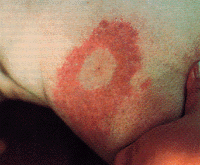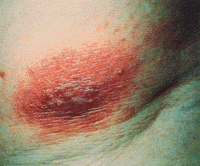|
Stage 1 / Localized Infection
The most common clinical manifestation
of Lyme disease is the rash,
erythema migrans, formerly called
erythema chronicum migrans (Figs.
6-9). The rash typically occurs 7-10
days after the tick bite and is
present in 60-80 percent of patients with
Lyme disease. Because over half of
the patients with Lyme disease do
not remember a tick bite, absence of
a history of a tick bite does not
exclude the diagnosis. The rash
typically has an erythematous
annular border that gradually
expands and has partial central
clearing (Fig. 6, 7). The rash can
occur anywhere on the body, is
typically warm to the touch, and
is occasionally pruritic. The median
diameter of the rash is 15 cm. Over
time the central portion of the rash
may become necrotic or vesicular
(Fig. 8). The rash usually
resolves within 3 to 4 weeks; if
antibiotic treatment is given, the rash usually fades by 1
week. Borrelia burgdorferi has been
isolated from the outer rim of the
skin lesion at this stage. During this
patients may also have
flu-like symptoms, regional
lymphadenopathy, and other non-specific
complaints.
|

Fig. 7 Erythema
migrans. Ross Ritter, P.A.
Click on thumbnail to see enlarged image.
|

Fig. 8 Erythema migrans with vesicular
center. Steven Luger, M.D.
Click on thumbnail to see enlarged image.
|
|